When it comes to protecting your online photography there are many ways to prevent people from copying or distributing your artwork.
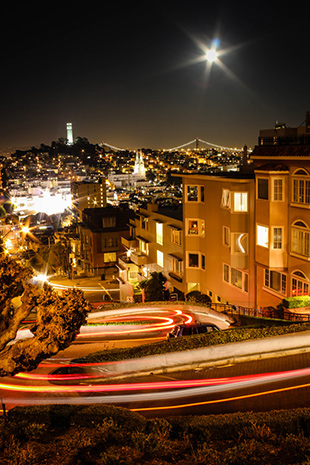
Lombard Street, SF
If you’re like me you’ve probably uploaded your precious photography at one time or another to either your own website/blog or to an online gallery such as 500px or Flickr. The benefit to showcasing your imagery is obvious; you want visitors to see your work, but you want your work to be secure and represented the way you want and, importantly, where you want.
Locating photography being used without your permission.
Google Images
The first thing I recommend is to visit the mighty Google Images page. Where Google.com is unmatched for searching textual data, Google Images is the king of pixel based searching. Google Images utilizes a special algorithm to find imagery that is exactly your work and imagery that is visually similar. The interesting thing with Google Images is that you can drag and drop your photos directly onto the search bar. Of course, if you want to be boring, you can always just use the camera icon.
TinEye
TinEye is another reverse image search engine. Very similar to Google Images but it offers many additional services including the ability to register your imagery. You can submit an image to TinEye to find out where it came from, how it is being used, if modified versions of the image exist.
Additionally, you can use it as a tool to locate higher resolution versions of imagery (which seems extremely hypocritical considering the nature of this article, but, I digress). Either way it’s tremendously useful for tracking down your online imagery.
Steps to Protect Your Photography From Theft
Watermarking is one of the most critical anti-plagiarism tools that you can deploy to combat the theft of your work. First off, it’s free and it solves two issues at once. One being that it visibly demonstrates that you want your work protected and that it’s not free or licensed for distribution. Secondly, it provides a level of self promotion back to your blog or online gallery which enhances the opportunity that your work will be credited or for that matter you get new clients, fans, or stalkers.
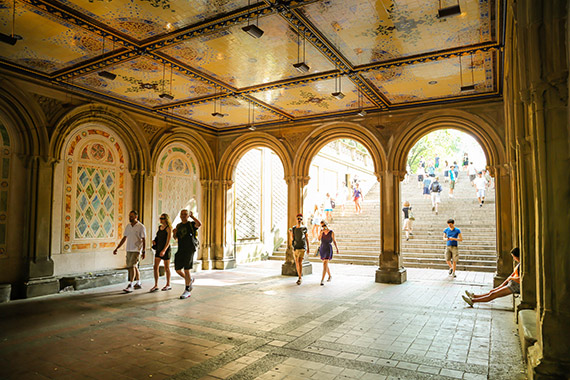
Central Park, NY
Where there are many options for watermarking—including visible and invisible—the standard for most photographers is to add your name to the bottom or side of your image. I personally recommend that you add your website, blog, or online gallery like 500px or Flickr to your watermark.
The option of visibly watermarking your image comes in two forms. One being my preferred method, a simple stamp at the bottom or along the side of your image. It’s a tasteful way of claiming ownership without obstructing the image. This way the experience for the viewer is pristine and if done correctly it will not steal any attention from your artwork.
The second version is the full image watermark. This method is reserved for those that absolutely want to maintain full control of your imagery. Unfortunately, this technique also obscures the photo and in my opinion ruins the ability to appreciate the art. However, I have used this watermark technique for a client that knew their work would be stolen. You can often see type of watermarking being used in stock art photography. Of course if the person stealing the image really wants they can take the time to clone out most watermarks albeit it’s never really done well.
Making a Legal Difference
If your watermark is removed by someone, you have a case under the copyright law for infringement which can provide additional damages against the accused violator. You can reference – 17 USC § 1202 – Integrity of copyright management information.
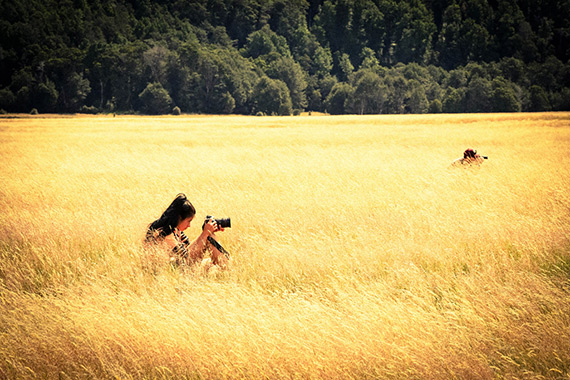
Photo location NZ
Metadata: The Good and the Bad
Many photographers are aware of the hidden data that is embedded into your digital files. One being EXIF which stands for “Exchangeable Image File Format” and is a standard that specifies the formats for images, sound, and ancillary tags used by digital cameras and now smartphones, scanners, and other systems. The other two forms of metadata that can be embedded are IPTC “International Press Telecommunications Council” and XMP “Extensible Metadata Platform”.
What Makes Metadata Amazing?
Let’s talk about the good part of metadata. For one, unless it’s deliberately removed it’s permanently attached to your image. In terms of this article, which is preventing photographic piracy, this is a digital blessing. Not only does it keep track of your cameras technical data, it also contains your copyright information.
Continuing on the plus side of metadata is the ability to add keywords to your photography. The value that this adds is often overlooked by most photographers. While the debate is out on if metadata is used by search engines, I have found through my experiences that it enhances SEO. I will be covering this with an article in the future.
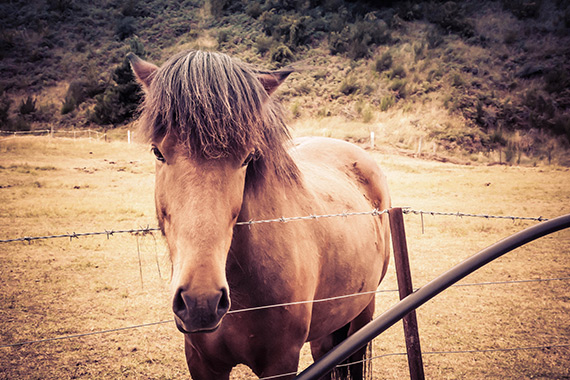
Friendly horse in Glenorchy, NZ
Adjusting the Copyright Info in Your Camera
Most DSLR cameras allow you to add some metadata directly into your photography via a menu in your camera settings. This ensures that every shot made with your camera is injected into the digital thread of your image. This is something that I HIGHLY recommend that you do.
Typically you can add several lines which include your copyright, name, and URL. While most photographers add this info when they’re processing their imagery, I prefer to have the data embedded to avoid forgetting to attach it later on.
Never Upload a Full Resolution Photo
If you’re planning on uploading imagery to your blog or to your favorite social media site, I recommend—more than any other tip on this page—to hold back from uploading the original resolution. For example, if I shoot with my Canon 7D at full resolution–18 mega-pixels–I will only upload, at the most, a 4 mega-pixel photo to any social site or online gallery. I tend to keep my imagery at about 1200px on the longest side for most of my online portfolio work.
First off, there have been many photographers lately who’ve had their work ripped off of social media only to be used overseas for stock art companies which sell the photos without paying you. Secondly, you can prove that the image is absolutely yours in the case that someone claims that they took the photo. Understandably, you can up-res photos to mimic a higher resolution but pixel peepers will be able to distinguish the fake.
Unless you’re selling your imagery online for digital prints or canvas work I would stay away from larger imagery. It just opens the door for digital thieves to plunder your talent.
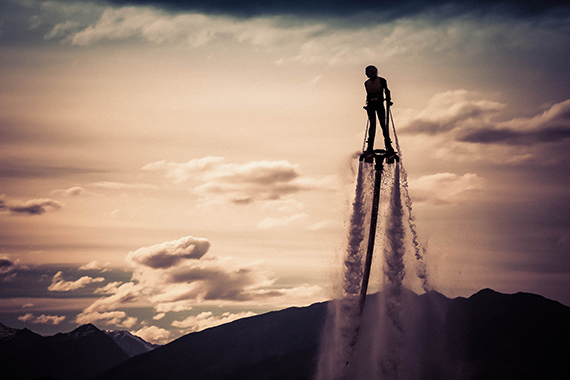
Watersports Flyer over Lake Wanaka, NZ
Ongoing Photography Vigilance
Google Alerts
This is a gem of a tip. If you’re serious about keeping track of your imagery, then Google alerts may be one of the best hidden tools you can utilize. Google Alerts allows you to set up keyword triggers that sends you an email based upon the criteria that you enter. In essence it can monitor the web for the exact content that you want.
This basically turns Google Alerts into your own personal spider bot. You can use it to enter your name. (I would use quotes to surround any specific term–for example, I have one set for my name “Erik Sacino”. This weeds out getting false readings.) Also, you can search for specific names of your images. You will want to make sure that you have a good nomenclature established to differentiate between your imagery and others. In the past, I have used a special alphanumeric combo such as “dragon_one_solargravity_3s88z2g3q.jpg. The chances of someone using “3s88z2g3q” is pretty rare and you should have no problem finding your work.
Give All of Your Photos a Unique Name
The interesting thing that I have found is that most digital thieves will not rename the photo. This works in your favor.
Additionally, I have discovered that when people steal your work they often rip the description directly from your image. This is actually a good thing since you can digitally tattoo your own words.
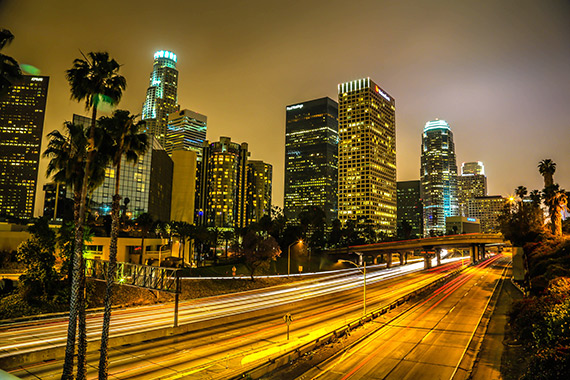
Downtown LA
My Example of a Unique Description Trigger
“This photo represents one of the most spectacular evenings I have ever photographed. The cloud to sky ratio, the majestic colors, the open field that I was in, all these variables aligned for me this evening. I knew at the time that this combination would only happen a few times in my life.”
In Google Alerts I have set up an alert to trigger on the phrase (notice the quotes) “cloud to sky ratio, the majestic colors, the open field”. This unique combination of words is as unique as a special 56 digit alphanumeric when used.
With a few easy steps you can really make a difference in preventing your photography from being uncredited or, even worse, sold online without your knowledge. Remember to watermark your imagery and to embed your copyright info into your metadata. Using a passive search tool like Google alerts will help assist you in your battle to guard your intellectual property.
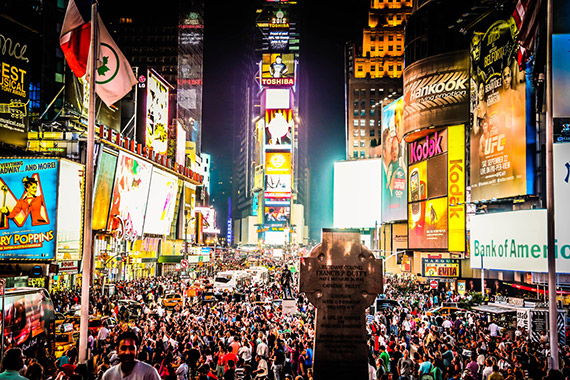
Times Square, NY
About the Author:
Erik Sacino is a motion artist, tech geek, photographer, blogger, designer, science fanatic, author, marketing addict and perpetual dreamer. Visit his blog and discover more (www.solargravity.com).
Like This Article?
Don't Miss The Next One!
Join over 100,000 photographers of all experience levels who receive our free photography tips and articles to stay current:

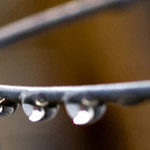




Think the best option was forgotten in this article. Signemo. https://www.signemo.com. This is a service that allows you to permanently embed your information right into the image shared online. It’s irreversible. Also it can be searched for by anyone, meaning your details are always associated with the image.
Adding a copyright notice into the metadata can indeed be used to try to protect your content. Other way is to preserve your original files. Some upload online only low-res images, which indeed do not attract thieves due to the quality of the image.
I think watermarking can also be effective if done properly. By done properly I mean designing your watermark and placing it without causing distraction from the photo itself. Because once you position it in the middle of the picture, you basically ruin it. If it helps, I recommend this post about watermarking tools for those interested in this option:
https://photomarksapp.com/blog/top-10-apps-for-batch-watermarking-photos-on-windows/
Thank you for this, this is exactly what I am looking for, I started wildlife photography and of course I want to share my images on social media, but I don’t know how to do it properly, because I heard of a friend who posted full resolution photo and someone steal it and sell somewhere
Really good tip on the Google Alert part, never thought of that. I’m a shoot and burn photographer, so client will have my files. But simply be able to tag myself in that photo or make a comment will help getting my brand out. Regarding watermark, yes it is true that you can sue someone for using it. However, as most of my clients are family. If they do steal it, I am not going to call a lawyer for the case. My normal course of action if/when I find out someone is cropping out watermark, is make a low resolution version uncropped and write why don’t you use this version instead. They will usually get the message and you just earned yourself a long term client.
You have some very nice tips here, especially for webmasters. I use tools like SquiggleMark to batch watermark my images. Like you said watermarking is a good way to promote one’s work. There is no stopping online piracy. I usually add a semi-transparent watermark with a link to my website at the bottom or middle. This way people can contact me for the original if they see my pictures.
Awesome! Very informative article.
I would (personally) also suggest the following (making it incredibly hard for anyone to steal your images):
For WordPress, I use WP Content Copy Protection available here: http://wordpress.org/plugins/wp-content-copy-protection/ – This plugin is used by over 115,000 users (self explanatory). They also have a pro version that uses some awesome image layering technology for SUPER image protection.
For non-WordPress, I would recommend this aggressive little jQuery plugin: http://www.securiilock.com/super-content-copy-protection-jquery/ (really good at protecting images and text content for any website). Very aggressive!
Cheers
Its really great review to know about this information..Thanks a lot for sharing your post.
Wow, what an interesting article! I don’t as a rule post many photo’s online but had never really thought about this at all!! I certainly shall now and will discuss with my husband who DOES post pic’s all the time. He will have to figure this stuff out and show me what to do because we should be protecting our photo’s. We take a lot of them when we travel and while neither of us is a professional, every now and then we have a few that turn out pretty good simply because we work at it and even amateurs get lucky now and then! :) Thank you so much for sharing this kind of information with those of us who have never had to deal with this kind of thing and didn’t realize we needed to! I also write a fair bit and while I haven’t yet gotten to the publishing stage (because my last computer blew up and I lost everything I’d worked on for the last 2 yrs and the backups I thought I’d done were corrupt due to virus’ …I’ve switched to a Mac and have backups scheduled regularly but I still have to start over, sigh) although I occasionally share a bit online with others to work on a piece and I shall be a lot more careful now and look into how I protect my work before I do that …. again, thank you so very much!
Hi There,
Its worth mentioning that none of these options can protect your entire image collection online on an ongoing basis.
I think this is critical from an ongoing management perspective.
Matt Johnson
http://www.imagewitness.com
If you are using WordPress, I would recommend WPCCP. They have a basic and premium version available. The premium version has image protection which works amazingly well.
The plugin can be found here: http://wordpress.org/plugins/wp-content-copy-protection/
They also have a testing area available here: http://www.securiilock.com/tester-page-2/
informative article thanks very much, all well said
thank you, Erik … all well said. shared on my FaceBook and Google+ pages.
I just followed the link to your blog from Elements Village. Interesting read and a still hot topic on blogs at the moment following the Hera Bell debacle copyright infringement.
Great images by the way!
I’m still a budding photographer, but as a librarian, I cannot recommend enough adding in Metadata into your pictures. (I add it in with Bridge). The downside to this though is that many programs strip the metadata when you re-save, etc etc
I can add the EXIF to my pics and upload them to Flickr with no problem.
But if I add it and upload to G+, the most basic data is removed for some reason. If I leave it untouched, G+ tells the viewer about the shutter speed, etc.
I would also add that if you are posting to your website(s) that you add some code to disable right-click/ save as.
Of course there are work-arounds to that, but my view is whatever it takes to make it a pain in the butt for thieves.
I enjoyed your article very much. I haven’t been copywriting anything, which I know is not good. I will be doing so shortly, Thanks
I think the addition of mentioning the services of Digimarc would be essential to this article. Even though it’s not free it’s quite useful.
Hi my name is Erik and I’m the author of this article. Thank you PictureCorrect.com for posting my write up on Protecting your online photography. It’s an honor for sure! Thank you again.
To read more of my articles please visit my blog http://www.solargravity.com
Erik